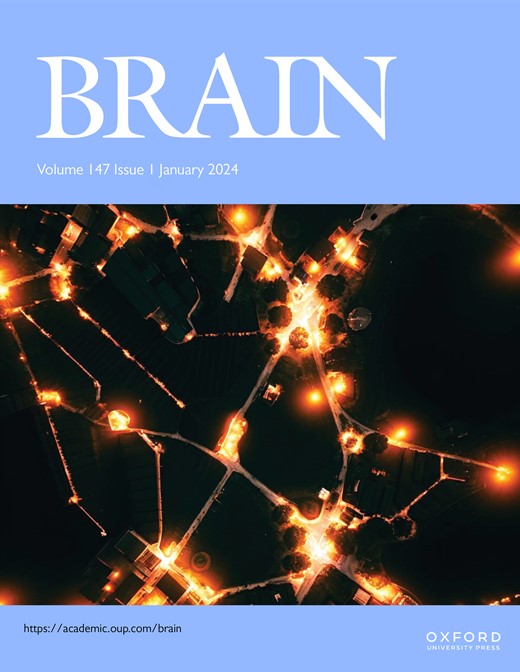In vivo self-assembled siRNAs ameliorate neurological pathology in TDP-43-associated neurodegenerative disease.
IF 11.7
1区 医学
Q1 CLINICAL NEUROLOGY
引用次数: 0
Abstract
Abnormal accumulation of TAR DNA-binding protein-43 (TDP-43) is a hallmark of amyotrophic lateral sclerosis (ALS) and frontotemporal lobar degeneration (FTLD). Small interfering RNAs (siRNAs) targeting TDP-43 offer potential therapeutic strategies for these diseases. However, efficient and safe delivery of siRNAs to the central nervous system (CNS) remains a critical challenge. Here, we present a synthetic biology-based approach that leverages endogenous small RNA processing machinery to self-assemble siRNA-encapsulating small extracellular vesicles (sEVs) and utilizes the host's natural circulatory system to transport siRNAs. Specifically, we engineered liver cells to express and package TDP-43-targeting siRNAs into rabies virus glycoprotein (RVG)-tagged sEVs, which are released into circulation and cross the blood-brain barrier to deliver siRNAs to the CNS. In a mouse model of TDP-43 pathology induced by stereotactic injection of mutant TDP-43 (M337V) virus, treatment with in vivo self-assembled TDP-43 siRNAs (IVSA-siR-TDP43) effectively reduced TDP-43 accumulation, leading to significant improvements in motor function and neuropathology. Additionally, an adeno-associated virus (AAV)-based delivery system was utilized to produce IVSA-siR-TDP43, demonstrating sustained therapeutic effects in TDP-43-associated neurodegeneration. These findings highlight a novel, effective, and minimally invasive gene therapy platform for addressing TDP-43 pathology in ALS and FTLD, offering a promising avenue for future clinical applications.体内自组装sirna改善tdp -43相关神经退行性疾病的神经病理学。
TAR dna结合蛋白43 (TDP-43)的异常积累是肌萎缩性侧索硬化症(ALS)和额颞叶变性(FTLD)的标志。靶向TDP-43的小干扰rna (sirna)为这些疾病提供了潜在的治疗策略。然而,如何高效、安全地将sirna传递到中枢神经系统(CNS)仍然是一个关键的挑战。在这里,我们提出了一种基于合成生物学的方法,该方法利用内源性小RNA加工机制自组装sirna封装的小细胞外囊泡(sev),并利用宿主的自然循环系统运输sirna。具体来说,我们设计了肝细胞,将靶向tdp -43的sirna表达并包装成狂犬病毒糖蛋白(RVG)标记的sev,这些sev被释放到循环中并穿过血脑屏障将sirna传递到中枢神经系统。在立体定向注射突变体TDP-43 (M337V)病毒诱导的TDP-43病理小鼠模型中,用体内自组装的TDP-43 sirna (IVSA-siR-TDP43)治疗可有效减少TDP-43的积累,导致运动功能和神经病理学的显著改善。此外,利用基于腺相关病毒(AAV)的递送系统生产IVSA-siR-TDP43,显示出对tdp -43相关神经退行性疾病的持续治疗效果。这些发现为解决ALS和FTLD中TDP-43的病理问题提供了一种新颖、有效、微创的基因治疗平台,为未来的临床应用提供了一条有希望的途径。
本文章由计算机程序翻译,如有差异,请以英文原文为准。
求助全文
约1分钟内获得全文
求助全文
来源期刊

Brain
医学-临床神经学
CiteScore
20.30
自引率
4.10%
发文量
458
审稿时长
3-6 weeks
期刊介绍:
Brain, a journal focused on clinical neurology and translational neuroscience, has been publishing landmark papers since 1878. The journal aims to expand its scope by including studies that shed light on disease mechanisms and conducting innovative clinical trials for brain disorders. With a wide range of topics covered, the Editorial Board represents the international readership and diverse coverage of the journal. Accepted articles are promptly posted online, typically within a few weeks of acceptance. As of 2022, Brain holds an impressive impact factor of 14.5, according to the Journal Citation Reports.
 求助内容:
求助内容: 应助结果提醒方式:
应助结果提醒方式:


